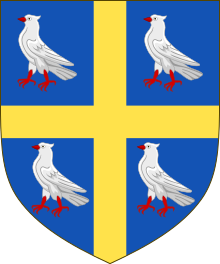John Writhe
John Writhe (died 1504) was a long-serving English
Heraldic career
It has been claimed that Writhe began his career as
Writhe was the first Garter of the College of Arms, which had been incorporated in March 1484. Contrary to popular belief,
Personal life
Writhe may have lived in Red Cross Street, adjoining Barbican House in London. After Writhe's death, his son Thomas styled him Sir John but there is no proof that he was ever knighted. His first marriage was to Barbara, daughter and heir of John Dunstanville. This union brought about the aforementioned Thomas (who was himself the father of Charles Wriothesley, Windsor Herald); William, York Herald; and two daughters, the elder of whom married John Mynne, another York Herald. Writhe died some time during May 1504 and was buried in St Giles-without-Cripplegate.
Arms

|
|
See also
- Herald
- King of Arms
Notes
- ^ "The Law of Arms - College of Arms".
- ^ Pollard, A. Dictionary of National Biography (OUP 1995)
- ^ Survey of London (London, 1905)
- ^ Godfrey, Walter H; Wagner, Anthony (1963). "'Garter King of Arms', in Survey of London Monograph 16, College of Arms, Queen Victoria Street (London, 1963), pp. 38-74". british-history.ac.uk. Retrieved 1 November 2018.
External links
Sources
- John Anstis. The Register of the Most Noble Order of the Garter. (London, 1724).
- Walter H. Godfrey and Sir Anthony Wagner, The College of Arms, Queen Victoria Street: being the sixteenth and final monograph of the London Survey Committee. (London, 1963).
- Mark Noble, A History of the College of Arms. (London, 1805).
- A. F. Sutton and P. W. Hammond. The Coronation of Richard III: The Extant Documents. (New York, 1984).
- Sir Anthony Wagner. Heralds of England: a History of the Office and College of Arms. (London, 1967).
- Sir Anthony Wagner. A Catalogue of English Mediaeval Rolls of Arms. Harleian Society (London, 1950), 100.
- The College of Arms - Explains credit for cadency system.
